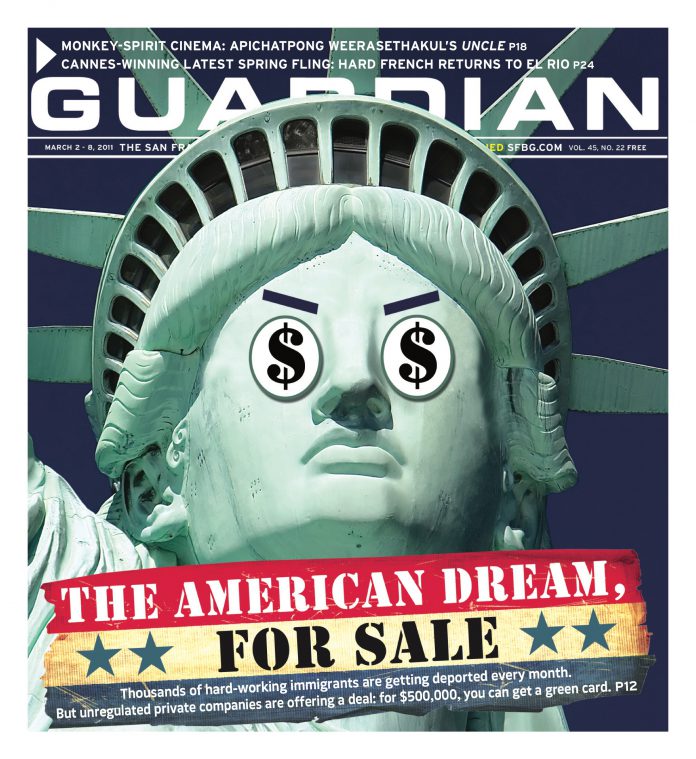arts@sfbg.com
FILM There are few contemporary filmmakers who grasp narrative as an expressive instrument in itself, and even among them Apichatpong Weerasethakul seems special. Like other influential artists from the provinces — he grew up in the rural northeast of Thailand — Apichatpong has developed a sui generis style by rethinking the shape of the container. When the transitional cinema of 2000-10 is recalled, his shorts, gallery installations, and five primary features (let us now praise them: 2000’s Mysterious Object at Noon, 2002’s Blissfully Yours, 2004’s Tropical Malady, 2007’s Syndromes and a Century, and now 2010’s Uncle Boonmee Who Can Recall His Past Lives) will appear uniquely evolved.
For those yet unconvinced, it’s important to note that while Apichatpong is sometimes pegged as a critic’s darling, he’s also highly esteemed by other filmmakers. I think this is because he entrusts the immersive qualities of sound and image and the intuitive processes of narrative. Like animals, his films change form as they move. Their regenerative story structures and sensuous beauty betray a motivating curiosity about the nature of perception as filtered through memory, desire, landscape, spirituality, and social ties. All of Apichatpong’s films have a science-fiction flavor — the imaginative leap made to invent parallel worlds that resemble our reality but don’t quite behave — but Uncle Boonmee is the first to dress the part.
It goes like this: Jen and her son Tong visit her brother-in-law Boonmee at his rural farm. Every evening, his attendant Rai, a migrant worker from Laos, drains Boonmee’s failing kidney. Spirits gather for the dying uncle; in a wonderfully framed and acted long scene around the dinner table, he is met by the ghost of his wife Huay and his son Boonsong, who since disappearing into the jungle with his camera has taken the form of an ape creature with electro-red eyes. Back in daylight, Boonmee tours Jen around the farm. They taste honey together, and he tells her that he thinks his illness is karmic retribution for killing too many Communists in the forest.
Before Boonmee finally commits himself to the cradle of a cave, there are excursions to the past; to unnamed alternate realities (a fantastic interlude in which, you may have heard, a princess finds love with a catfish); and to dreams of the future. Back in the city, Jen and her daughter tally donations for Boonmee’s funeral. Tong comes to the door, only now he’s a monk. He wants a shower and something to eat — earthly things.
This is the gist, but not the grain. For that, you need the enveloping sound field of the jungle; the sly style of cutting that configures the jumps between worlds as if they were reaction shots; the day-for-night jungle saturating every inch of the frame; the many unenclosed shelters from porch to cave. These formal features are porous, as should be the film’s appeal. That the film won the Palme d’Or at the 2010 Cannes Film Festival was instantly claimed as a triumph for film culture (which it was), but Uncle Boonmee has something to say to those interested in Buddhism, installation art, Jung, astrophysics, experimental music, animism … I could go on. If that list makes it sound a very San Francisco-appropriate movie, that’s not wrong either.
Within the film itself, the central themes of transmigration and reincarnation are widened every step of the way. The supernatural visitations clearly echo the presence of illegal “aliens,” for instance, just as the monkey-spirits and omnipresent insects evoke the lingering memory of those massacred Communists troubling Boonmee’s final hours. And yet Boonmee feels nothing like a dutiful allegory, in part because its unordered clusters of association ensure many prisms through which to apprehend its compounded light.
Another is cinema. Apichatpong has explained that he conceived of Uncle Boonmee‘s stylistic shifts as a panorama of film history. Distinct passages recoup Thai costume drama, idyllic French verité, TV family drama, and Apichatpong’s own long take style. The transformations call attention to yet another medium, and work to crystallize two resonant aspects of cinema’s temps perdus: its disembodied nature and vicarious consummation of the past. Film has itself entered a Boonmee-like twilight, so when Apichatpong refers to Uncle Boonmee‘s spirit of lamentation in interviews, he’s talking as much about the vessel as the story.
But one need not decipher symbols to enjoy Apichatpong’s films — it’s a matter, rather, of sharing in his sensibility. Like all his work, Uncle Boonmee has a strong basis in Apichatpong’s own idiosyncratic personal history. But the film has the same relationship to autobiography as Mysterious Object at Noon did to ethnography. That film used the surrealist game of exquisite corpse as a model to interact with documentary subjects. Apichatpong traveled from city to country on narrative threads invented, elaborated on, and acted out by those appearing on camera. The premise is that the kernels of individual experience and insight can be followed to something like collective knowledge — that we might locate the self, in other words, between selves. None of the secondary readings are remarkable in themselves; it’s the connectedness that counts.
UNCLE BOONMEE WHO CAN RECALL HIS PAST LIVES opens Fri/4 at the Sundance Kabuki.

